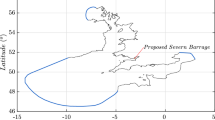Abstract
Details are given herein of the current main proposals for tidal energy provision from the Severn Estuary, in the UK, with particular emphasis being focused on the Severn Barrage project, as originally promoted by the Severn Tidal Power Group. In particular, emphasis has focused on assessing the potential hydro-environmental impacts and power outputs of a barrage across the estuary, with an unstructured grid, high resolution, model being developed and applied to the estuary to assess the implications of each of five shortlisted proposed schemes on the hydrodynamic, geomorphologic, flood risk and faecal indicator organism changes within the estuary. An outline is given of recent research on power refinements to the model to assess the options for power generation. The results show that the Severn Barrage has the potential to reduce the tidal currents in a highly dynamic estuary. This leads to the reduction of suspended sediment loads (particularly upstream of the barrage), an increase of light penetration within the water column and, potentially, an increase in the benthic bio-diversity and the level of aquatic life in the estuary. The results also show that the Severn Barrage will reduce markedly the risk of flooding upstream of the barrage and to a lesser extent downstream of the structure. In contrast the alternative options have far less impact on flood risk changes. In addition to the Severn Barrage some results are shown herein for a typical lagoon option, namely the Fleming Lagoon.
Similar content being viewed by others
References
Owen A. A three-dimensional model of the Bristol Channel. J Phys Oceanography, 1980, 10: 1290–1302
Uncles R J. A numerical simulation of the vertical and horizontal M2 tide in the Bristol Channel and comparisons with observed data. Limnology Oceanography, 1981, 26(3): 571–577
Uncles R J. Hydrodynamics of the Bristol Channel. Mar Pollut Bull, 1983, 15(2): 47–53
Uncles R J, Jordan M B. Measurements of tidal currents and estimated energy fluxes in the Bristol Channel. In: Beven K J, ed. Mixing and Transport in the Environment. Chichester: John Wiley, 1994. 221–245
Stephens C V. A three-dimensional model for tides and salinity in the Bristol Channel. Continental Shelf Res, 1986, 6(4): 531–560
Evans G P, Mollowney B M, Spoel N C. Two-dimensional Modelling of the Bristol Channel, UK. In: Spaulding M L, ed. Proceedings of the Conference on Estuarine and Coastal Modeling, 1990. 331–340
Amin M, Flather R A. Investigation into the possibilities of using Bristol Channel Models for tidal predictions. In: Spaulding M L, Cheng R T, eds. Proceedings of the 4th International conference on Estuarine and Coastal Modelling. San Diego, California, American Society of Civil Engineers, 1995. 41–52
Barber R W, Scott R J. Numerical modeling of tidal propagation in the Severn Estuary using a depth-adapted non-orthogonal grid. In: Rodriguez G R, ed. Environmental Coastal Regions III. WIT Press, 2000. 126–136
Harris E L, Falconer R A, Lin B. Modelling hydroenvironmental and health risk assessment parameters along the South Wales Coast. J Env Manag, 2004, 73: 61–70
DECC. Analysis of options for tidal power development in the Severn Estuary. Interim Options Analysis Report, 2008, 1–2: 237
Proudman Oceanographic Laboratory POLPRED for Windows User Guide. 2004. 1–6
Yang L, Lin B, Falconer R A. Modelling enteric bacteria levels in coastal and estuarine waters. Proc Inst Civil Eng, Eng Comput Mech, 2008, 161(4): 179–186
Baker A C. Tidal Power. The Institute of Engineering and Technology, London, 2006. 250
Goldwag E Potts R. Energy Production. In: Developments in Tidal Energy, Proceedings of the Third Conference on Tidal Power, The Institution of Civil Engineers. London: Thomas Telford, 1990. 75–92
Kashefipour S M, Lin B, Harris E L, et al. Hydro-environmental modelling for bathing water compliance of an estuarine basin. Water Res, 2002, 36(7): 1854–1868
Author information
Authors and Affiliations
Corresponding author
Additional information
Supported by the Flood Risk Management Research Consortium (Phase II), the UK Engineering and Physical Sciences Research Council (GR/S76304) and the Welsh Assembly Government European Regional Development Fund, Project HE09
Rights and permissions
About this article
Cite this article
Falconer, R.A., Xia, J., Lin, B. et al. The Severn Barrage and other tidal energy options: Hydrodynamic and power output modeling. Sci. China Ser. E-Technol. Sci. 52, 3413–3424 (2009). https://doi.org/10.1007/s11431-009-0366-z
Received:
Accepted:
Published:
Issue Date:
DOI: https://doi.org/10.1007/s11431-009-0366-z




